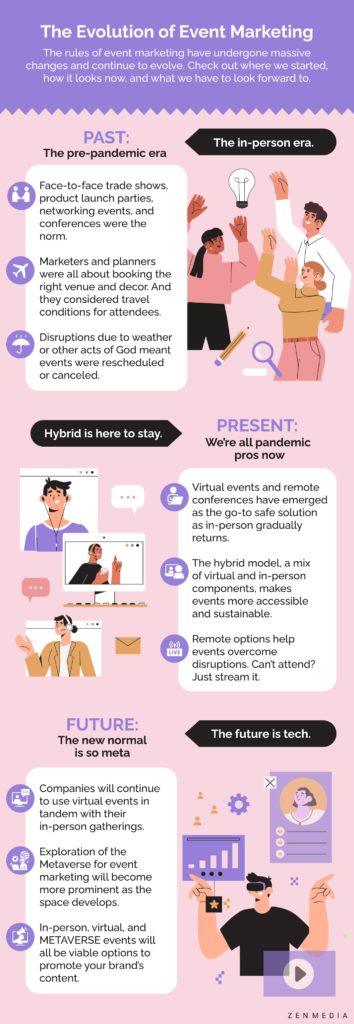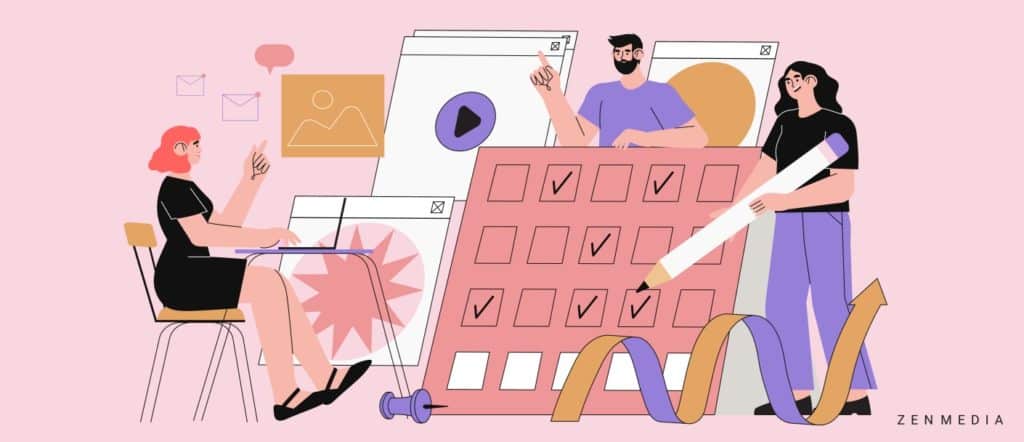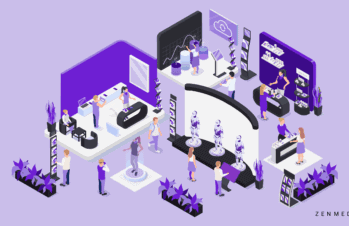To anyone who’s been paying attention, it’s obvious that B2B event marketing has gone through some drastic changes in the last few years.
We’re all tired of talking about the pandemic at this point, but its impact can’t be ignored. From mingling in person, to events being canceled, to going remote, to baby steps back into the in-person events world—the evolution of events marketing has been swift and in constant flux. And that is a clear indication of how important events are.
Even in the most challenging of circumstances, we’ve taken whatever steps necessary to continue holding events. And the data shows that this focus on events will continue, with the global events industry expecting to surge at a growth rate of 11.2% over the next six years.
Today, we are navigating a new landscape that continues to evolve as we find more ways to market and sell events and improve the overall experience of attendees. Let’s take a look at events from the not-so-distant past, the present, and our predictions for the future.

The Ghost of Events Marketing Past
Tradeshows, conferences, summits, roundtables—events in the not-so-distant past were a common part of any company’s B2B marketing strategy. Events were used not only to launch new products and engage with prospects, but also to create industry connections, build relationships and partnerships, and cultivate internal company culture.
Related reading: How to Market a Conference: The Ultimate Guide to Making Your Event a Success
From multi-national companies to local markets, all businesses that relied on in-person meetings were staggered and faced heavy losses. As a consequence of the pandemic, the idea of gathering hundreds of buyers, brand representatives, and other industry leaders into a single room to show off new products and services went from a common marketing tactic to an unthinkable—and in many parts of the world, illegal—concept. But, back then, it was what people wanted and looked forward to.
Our New Normal
Fast forward to the present, current event marketing tactics are significantly different from those that were in place before the COVID-19 pandemic. Virtual events and remote conferences have emerged as the go-to safe solution to keep event marketing going during the pandemic. Our post-pandemic world has seen a resurgence in in-person events, but it’s clear that virtual and hybrid events are now an expectation of consumers. Simply put, the virtual trend is here to stay and will remain in place indefinitely until consumers decide to move on to something bigger and better—but they probably won’t, and not just because of public safety concerns. Taking events remote gave event marketers access to a broader audience. Online options help reduce limitations like distance and funds for attendees, and they don’t require expensive venues, caterers, and travel accommodations.
Webinars are the standard choice for virtual events as they are straightforward, relatively easy to put together, and are proven to be effective. Going live—which is to say, livestreaming on social media—is another way to hold a virtual event. Livestream events can be impromptu—planned just moments before, or they can be planned in advance. Livestream podcasts have made a space in the marketing industry. They are ideal options for thought leaders who want to provide valuable content with a regular cadence.
While virtual events are also much easier to reschedule, adjust, and even cancel outright than live events, they just can’t—and won’t—replace in-person events.
People were excited to connect and network in person when COVID-19 infection restrictions began to drop significantly. With a hybrid event model, attendees can attend events virtually, from multiple locations in-person, or both. It’s the best of both worlds. Those who want to and can afford to attend in person don’t lose that opportunity, and events can expand their reach by creating a space for people to attend virtually. The ratio of one audience to the other doesn’t really matter because a hybrid event is created to connect multiple audiences to one event.
And that’s just the tip of the events marketing iceberg!
The use of virtual events can extend the shelf life of your branded content and circulate your business throughout different consumer groups, especially when it’s marketed correctly. Exploring B2B influencer marketing in tandem with your event marketing to generate buzz around your events can work wonders for your business.
This is the idea behind the Zendaya Method—where, instead of companies using their events as the primary experience, they view events as tipping points.
People should already have an idea of who you are when they attend your event, and their experience should make them want to know more.
The Future Is Bright
Among the many lessons to emerge from the pandemic is the potential for virtual platforms to bring people together, but we know that doesn’t mean in-person events are going away. According to the DBC Industry calendar, ad industry events are now more commonly held in person than as exclusively virtual happenings.
And the B2B exhibit industry cancellation rate shows that no-shows are ready to show up:
- Q4 of 2020 – 97.9%
- Q4 of 2021 – 12.5%
As social beings, we all desire in-person experiences, and experiential and events marketing will continue to be a part of our future.
While the past year has taught us that predicting the future is an exercise in futility, all signs point to the emergence and dominance of the hybrid model.
The switch from a physical to digital space has not only been essential for preventing significant financial loss, but also for proving the agility of marketers in times of crisis. Virtual events, as well as hybrid events that mix virtual and in-person components, tend to be more sustainable and environmentally friendly than solely in-person gatherings.
But with more events happening than ever and more ways for individuals to engage with those events, the bar is even higher for the quality of an event. Potential attendees need to consider their budgets and time constraints, so they will only attend the best of the best. Hiring in-demand speakers and creating unique opportunities for attendees is the only way to compete now.
Additionally, this level of skepticism and critical thinking about how we spend our time has made B2B buyers, including event ticket buyers, demand credibility before considering an offer. B2Bs need to provide evidence that their event is worth attending. How can they do that? Third-party credibility through earned media and influencer partnerships.
Like the Zendaya Method we mentioned above, strategic brand partnerships can make for incredible events. Partnering with an influencer or other brand can help marketers build interest in an event before it’s launched, which is crucial to event marketing success.
Related reading: 13 Keys to Event Marketing in 2023 (And Beyond)
Looking to make a splash and have budget to spare? Big players like SXSW used the Metaverse to lure attendees to their event.
The metaverse strives to provide opportunities for brands to create highly engaged communities and provide experiences you most likely won’t find anywhere else. Companies can generate a wealth of knowledge from the data-heavy metaverse and tie avatar behaviors to the real people that use them. For marketers, this will expand your knowledge of your event attendees, and enable you to reach even further, opening up new doors to promote your brand’s content.
Related reading: Metaverse Marketing: A Brave New (Virtual) World
The metaverse is only in its infantile stage, so there’s a lot more to learn about its capacities and limitations, or lack thereof. Based on Forrester’s 2023 trend predictions, we don’t expect the metaverse to play a huge role in B2B marketing efforts until the VR-enthusiast community grows. Still, if it’s within your budget, it’s not a bad idea to do some metaverse research to see how your brand can become an early adopter of metaverse technology.
We are still in a time of constant evolution, and to keep up, you must be agile and willing to adapt. Whether you took your events online in 2020 and back offline in 2022, whether you’re considering an impromptu livestream event or scheduling a hybrid product launch, whether you’re designing a networking activity for your virtual event or scheduling an in-person exclusive—be flexible, listen to your audience, and make sure your event is just the tipping point—not the whole strategy. Need help planning your event? Let’s get in touch.





